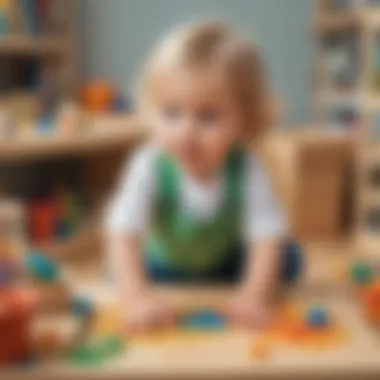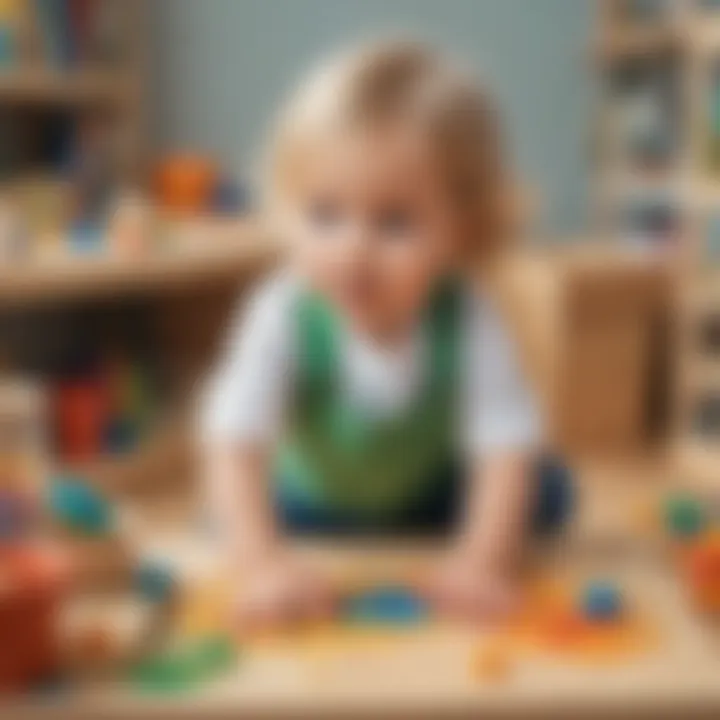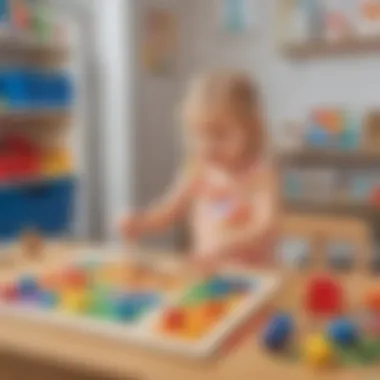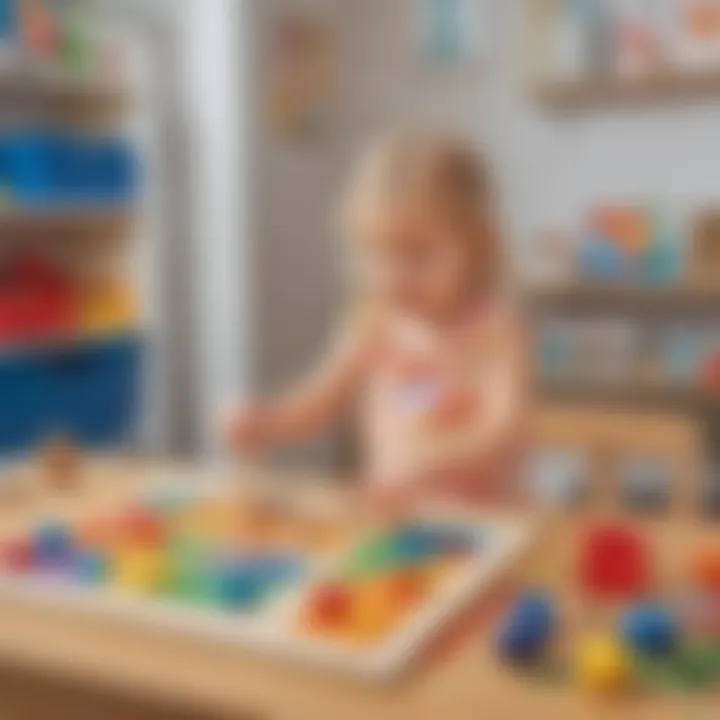Unleashing the Wonders of Sensory Play for 3-Year-Olds


Creative Activities
When it comes to sensory games for 3-year-olds, creativity plays a vital role in their development. Engaging children in craft ideas not only fosters their imagination but also enhances their fine motor skills. Simple activities like finger painting, playdough sculpting, and collage making can ignite their artistic flair. These craft ideas are designed to be easily replicable with everyday household items, encouraging children to explore their creativity in a tactile and interactive manner.
Craft Ideas
Let's delve into some creative craft ideas that are perfect for 3-year-olds:
- Finger Painting Fun: Finger painting is a fantastic sensory activity that allows children to explore different textures and colors. Encourage your child to dip their fingers in non-toxic paint and create masterpieces on paper or cardboard.
- Playdough Playtime: Playing with playdough engages children's senses of touch and smell. Guide them to roll, shape, and mold the playdough into various forms, stimulating their fine motor skills and creativity.
- Collage Creations: Collage making is a versatile activity that develops children's hand-eye coordination and pattern recognition. Provide them with magazines, colored paper, and glue to create personalized collages, enhancing their artistic expression.
Step-by-Step Guides
For each craft idea mentioned, here are detailed step-by-step guides to ensure a seamless creative experience:
- Finger Painting Fun:
- Playdough Playtime:
- Collage Creations:
- Set up a designated painting area with newspapers or a drop cloth.
- Pour small amounts of paint onto a palette or paper plate.
- Encourage your child to dip their fingers in the paint and create patterns or images on paper.
- Allow the artwork to dry before displaying or storing.
- Provide your child with different colored playdough.
- Demonstrate how to roll, flatten, and shape the playdough using hands and simple tools.
- Let them explore creating various shapes and figures with the playdough.
- Store the playdough in airtight containers after use to maintain freshness.
- Collect a variety of materials like magazines, colored paper, feathers, buttons, and fabric scraps.
- Let your child cut or tear the materials into desired sizes and shapes.
- Show them how to glue the pieces onto a larger sheet of paper to create a collage.
- Display their finished collages proudly or use them for gifting purposes.
Educational Value
Engaging in these creative activities goes beyond just fun; they hold substantial educational value for 3-year-olds:
- Cognitive Development: Crafting stimulates cognitive skills by encouraging decision-making, problem-solving, and creativity.
- Fine Motor Skills: Activities like finger painting and collage making enhance children's hand-eye coordination and finger dexterity.
- Sensory Stimulation: Exploring different textures, colors, and materials enriches sensory awareness and perception.
- Language Development: Encouraging children to describe their artwork or process fosters linguistic abilities and expression.
Crafting with sensory games not only entertains your child but also nurtures their holistic development, making learning a playful adventure.
Introduction
Understanding the Importance of Sensory Play
Developmental Benefits
The developmental benefits of sensory play are profound, influencing various aspects of a child's growth and learning. By engaging in sensory activities, children can enhance their cognitive abilities, fine motor skills, and sensory processing. This hands-on approach to learning not only stimulates their imagination but also strengthens their problem-solving skills and memory retention. The hands-on experience offered by sensory play provides children with a concrete understanding of abstract concepts, laying a solid foundation for future learning endeavors.


Stimulating Multiple Senses
Stimulating multiple senses through sensory play is essential for holistic development. By engaging various senses such as touch, sight, sound, and smell, children can experience a comprehensive learning process that fosters sensory integration. This multisensory approach not only enhances their cognitive abilities but also promotes language development and emotional regulation. By immersing children in activities that target multiple senses, parents and caregivers can help them make connections between different stimuli, fostering a deeper understanding of the world around them.
Age-Appropriate Activities
Tailoring Games for Toddlers
Tailoring sensory games for toddlers requires a keen understanding of their developmental needs and abilities. By incorporating age-appropriate materials and activities, parents and caregivers can create a safe and engaging play environment that promotes exploration and discovery. By tailoring games for toddlers, adults can ensure that the activities are not only fun but also educational, laying the groundwork for future learning.
Adapting for 3-Year-Olds
Adapting sensory games for 3-year-olds involves building on the skills acquired during toddlerhood while introducing new challenges and experiences. This age group is characterized by increased independence and curiosity, making them eager learners. By adapting activities to suit the unique needs and interests of 3-year-olds, parents and caregivers can provide them with opportunities to develop critical thinking skills, creativity, and social abilities. Through age-appropriate adaptations, children can engage in sensory play that aligns with their cognitive and emotional development, fostering a positive and enriching learning experience.
Types of Sensory Games
Sensory games play a pivotal role in stimulating a child's cognitive and sensory development. The variety in types of sensory games ensures a well-rounded approach to engaging a 3-year-old's senses. By incorporating activities that focus on different senses, such as touch, sight, and sound, children can enhance their sensory exploration and cognitive abilities. Tailoring these games for 3-year-olds is crucial to ensuring age-appropriate challenges and stimulation that promote growth and learning. Age-appropriate games foster a sense of accomplishment and curiosity in young minds, setting a strong foundation for future learning experiences.
Texture Exploration
Sensory Bins
Sensory bins are a fantastic way to introduce young children to different textures and materials, promoting sensory development and fine motor skills. These bins typically contain various tactile elements like rice, beans, or sand, providing a hands-on experience for children to explore different sensations. The versatility of sensory bins allows for endless possibilities in creating themed sensory bins tailored to a child's interests, encouraging imaginative play and creativity. While sensory bins offer a multisensory experience, it's essential to ensure child-safe materials and supervise play to prevent any potential hazards.
Touch-and-Feel Books
Touch-and-feel books are interactive tools that engage both the sense of touch and sight, making them a valuable asset in a 3-year-old's sensory exploration journey. These books feature textured elements that children can feel and explore, enhancing their tactile perception and language skills as they engage with the narrative. The inclusion of sensory elements in storytelling fosters a deeper connection with the content and can spark curiosity and imagination in young readers. When selecting touch-and-feel books, opt for durable editions with age-appropriate textures to ensure a safe and enjoyable reading experience.
Sensory Art Activities
Finger Painting
Finger painting is a classic sensory art activity that provides a hands-on creative outlet for young children to express themselves. This tactile experience allows children to explore color mixing, patterns, and textures, enhancing their fine motor skills and creativity. Engaging in finger painting promotes sensory stimulation and cognitive development, as children learn to control movements and experiment with different techniques. To maximize the benefits of finger painting, use non-toxic and washable paints, set up a designated art space, and encourage free artistic expression to boost confidence and curiosity.
Playdough Creations
Playdough offers a versatile medium for sensory play, allowing children to mold, shape, and manipulate the dough to create various designs and structures. This sensory activity enhances hand-eye coordination, strengthens hand muscles, and promotes imaginative play. Through playdough creations, children can explore different textures, colors, and shapes, fostering creativity and problem-solving skills. When engaging in playdough activities, incorporate tools like rollers, cutters, and stamps to encourage fine motor practice and artistic exploration.


Benefits of Sensory Games
Sensory games play a significant role in the holistic development of 3-year-olds by engaging their senses and enhancing various skills. In this article, we will delve deep into the key benefits that sensory games offer to young children. These activities are not just recreational but also serve as powerful tools for learning and growth. By actively involving children in sensory play, we can foster their cognitive, emotional, and social abilities. Understanding the impact of sensory games can help parents and caregivers create enriching experiences for their little ones, promoting overall well-being and development.
Cognitive Development
Enhanced Problem-Solving Skills
Improved Memory Retention
Memory retention is a crucial component of cognitive development, crucial in a child's learning journey. In the context of sensory games, improved memory retention refers to the capacity of children to store and retrieve information effectively. By participating in activities that challenge memory recall and recognition, 3-year-olds can enhance their cognitive abilities and information processing skills. Improved memory retention not only aids in academic pursuits but also equips children with the mental tools to navigate daily tasks efficiently. This aspect of sensory games contributes significantly to shaping a child's cognitive prowess, promoting adaptive learning strategies and mental agility.
Emotional Regulation
Stress Relief
Within the realm of sensory games, stress relief emerges as a critical element in nurturing emotional regulation among 3-year-olds. Stress relief activities aim to provide children with outlets to unwind, relax, and alleviate anxiety or tension. These sensory experiences create calming environments, promoting emotional well-being and stability. Stress relief techniques introduce youngsters to coping mechanisms that allow them to manage emotions positively and develop resilience in the face of challenges. By integrating stress relief activities into playtime, parents and caregivers can support children in cultivating emotional intelligence, self-awareness, and healthy stress management skills.
Self-Soothing Techniques
Sensory games offer a platform for children to explore self-soothing techniques, fostering emotional regulation and self-care practices. Self-soothing techniques involve activities that help children learn to comfort themselves, regulate their emotions, and find solace in times of distress. These techniques empower youngsters to cope with discomfort, fear, or frustration independently, promoting emotional resilience and inner strength. Self-soothing practices introduced through sensory games can become valuable tools for 3-year-olds, enhancing their emotional well-being, self-confidence, and ability to navigate complex feelings with composure.
Guidelines for Engaging 3-Year-Olds
Setting up the Environment
Safe and Stimulating Spaces
When it comes to providing safe and stimulating spaces for 3-year-olds, the emphasis lies on creating an environment that balances security with sensory engagement. Safety measures like soft padding, rounded edges, and non-toxic materials ensure physical well-being during play. Simultaneously, incorporating stimulating elements such as vibrant colors, interactive toys, and varied textures captivates young minds, encouraging exploration and creativity. Safe and stimulating spaces offer the ideal setting for children to engage in sensory games while feeling secure and inspired to learn.
Organized Play Areas
Organized play areas play a pivotal role in facilitating structured play experiences for 3-year-olds. These spaces are designed to offer a clear layout that allows children to navigate the environment easily. Utilizing storage solutions for toys and incorporating designated play zones aid in promoting independence and organization skills. The distinctiveness of organized play areas lies in their ability to create a sense of orderliness and purposeful play. While they provide an enriching environment for sensory games, they also instill a sense of routine and responsibility in young children, fostering autonomy and confidence.
Encouraging Exploration
Allowing Freedom to Discover


Granting 3-year-olds the freedom to discover ignites their natural curiosity and fosters a sense of independence. Allowing them to explore their surroundings without constant restriction nurtures their decision-making skills and self-confidence. This approach empowers children to engage in sensory activities at their pace, honing their abilities to observe, experiment, and problem-solve. By encouraging autonomy in exploration, adults can support children in cultivating a sense of agency and intrinsic motivation towards learning.
Supervising from a Distance
Supervising 3-year-olds from a distance involves striking a delicate balance between ensuring their safety and facilitating independent exploration. By maintaining a watchful eye from a distance, caregivers can intervene when necessary while allowing children the space to explore autonomously. This approach enables children to develop self-reliance and critical thinking skills while offering a safety net in case of emergencies. Supervising from a distance fosters a sense of trust between adult and child, promoting a healthy and evolving relationship built on encouragement and support.
Engagement Strategies
Engagement strategies play a pivotal role in the realm of sensory games for 3-year-olds. These strategies act as catalysts, igniting children's curiosity and enhancing their overall learning experience. By incorporating interactive elements, such as role-playing scenarios and interactive storytelling, caregivers can create stimulating environments that promote cognitive development and emotional regulation. Engagement strategies provide a structured yet flexible approach to sensory play, allowing children to explore and experiment while supporting their individual growth and creativity.
Incorporating Interactive Elements
Interactive elements are crucial components of sensory games, adding depth and dynamism to the play experience. One key aspect is role-playing scenarios, which enable children to immerse themselves in different roles and environments, fostering imagination and social skills. Role-playing scenarios also cultivate empathy and communication, empowering children to express themselves freely. On the other hand, interactive storytelling captivates young minds through narrative engagement, encouraging active participation and sparking creativity. It enhances language skills, cognitive abilities, and emotional understanding, making learning an enjoyable and meaningful experience.
Multi-Sensory Experiences
In the realm of sensory games for 3-year-olds, multi-sensory experiences open a world of exploration and discovery. Combining different stimuli, such as sight, sound, touch, and even taste, allows children to engage all their senses simultaneously. This holistic approach not only enhances sensory awareness but also promotes neural connections and cognitive development. Varied textures and materials further enrich these experiences, offering tactile stimulation and fostering sensory integration. By incorporating diverse sensory inputs, caregivers can create rich and immersive environments that spark curiosity, encourage exploration, and support overall sensory processing abilities.
Safety Measures
Safety measures play a pivotal role in ensuring the well-being and security of children during sensory play activities. Prioritizing safety not only prevents accidents but also fosters a conducive environment for immersive learning experiences. In the realm of sensory games for 3-year-olds, understanding and implementing appropriate safety measures are paramount. They encompass various aspects such as supervision, monitoring, and maintaining hygiene standards to create a safe haven for children to explore.
Supervision and Monitoring
When it comes to ensuring child safety, constant supervision is key. By actively monitoring their actions and interactions, caregivers can promptly address any potential risks or hazards that may arise. Supervision also allows for quick intervention in case a child encounters difficulties or needs assistance. The emphasis on supervision within the context of sensory games for toddlers underscores the importance of attentiveness and alertness to guarantee a secure play environment.
Ensuring Child Safety
Ensuring child safety involves vigilantly observing and supervising children during sensory activities to mitigate potential dangers. Adhering to safety protocols and guidelines tailored for the specific age group can significantly reduce the likelihood of accidents. The fundamental characteristic of ensuring child safety lies in proactively preventing harm and prioritizing the well-being of children engaged in sensory play. This approach is widely regarded as an effective and indispensable component of fostering a safe and nurturing play environment.
Understanding Choking Hazards
Understanding the risks associated with choking hazards is crucial in safeguarding children during sensory games. Recognizing potential choking hazards such as small objects or loose parts is essential for implementing preventive measures. By comprehending the distinct characteristics of items that pose choking risks, caregivers can strategically choose and manage play materials to minimize such dangers. Acknowledging and addressing choking hazards conscientiously within the context of sensory activities significantly enhances the overall safety standards for young children.
Cleaning and Sanitization
Maintaining cleanliness and hygiene standards is essential in preserving a safe and healthy play environment for children. Regular disinfection of toys and play areas minimizes the spread of germs and pathogens, reducing the risk of infections or illnesses. Emphasizing proper cleaning practices not only safeguards children from potential health hazards but also instills good hygiene habits from an early age.
Regular Toy Disinfection
Regular toy disinfection involves cleaning and sanitizing play items to eliminate germs and bacteria, ensuring a hygienic play environment. By regularly disinfecting toys, caregivers can create a sanitized space for children to engage in sensory activities without exposure to harmful microorganisms. The key characteristic of this practice lies in promoting health and well-being through the removal of potential pathogens that may compromise children's safety.
Maintaining Hygienic Practices
Maintaining hygienic practices encompasses a broader perspective beyond toy disinfection. It encompasses overall cleanliness in play areas, encouraging children to adopt hygienic habits. By emphasizing the importance of hygiene in sensory play settings, caregivers instill a sense of responsibility and awareness regarding cleanliness. The unique feature of maintaining hygienic practices lies in cultivating a culture of cleanliness and well-being, contributing to a safe and nurturing environment for young children.







